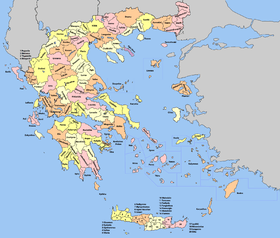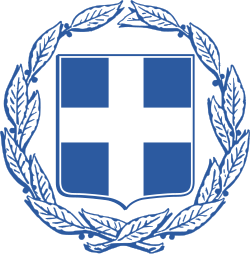Provinces of Greece
The provinces of Greece (Greek: επαρχία, "eparchy") were sub-divisions of some the country's prefectures. From 1887, the provinces were abolished as actual administrative units, but were retained for some state services, especially finance services and education, as well as for electoral purposes. Before the Second World War, there were 139 provinces, and after the war, with the addition of the Dodecanese Islands, their number grew to 147. According to the Article 7 of the Code of Prefectural Self-Government (Presidential Decree 30/1996), the provinces constituted a "particular administrative district" within the wider "administrative district" of the prefectures. The provinces were finally abolished after the 2006 local elections, in line with Law 2539/1997, as part of the wide-ranging administrative reform known as the "Kapodistrias Project", and replaced by enlarged municipalities (demoi).

| This article is part of a series on |
| Politics of Greece |
|---|
 |
|
Judiciary
|
|
|
|
Organisation
Provincial administration consisted of two parts: a collective Provincial Council and an eparch (Greek: έπαρχος). Members of the Provincial Council were the prefectural councillors of the respective province. The eparch or sub-prefect was the prefectural councillor who received the most votes in the prefectural elections.
List
This is a list of the former provinces of Greece and their capitals, sorted by prefecture, as they stood in 1991:[1]
- Achaea
- Aetolia-Acarnania
- Missolonghi Province - Missolonghi
- Nafpaktia Province - Nafpaktos
- Trichonida Province - Agrinio
- Valtos Province - Amfilochia
- Vonitsa-Xiromero Province - Vonitsa
- Arcadia
- Gortynia Province - Dimitsana
- Kynouria Province - Leonidio
- Mantineia Province - Tripoli
- Megalopoli Province - Megalopoli
- Argolis
- Arta Prefecture: no provinces
- Athens Prefecture: no provinces
- Boeotia
- Thebes Province - Thebes (Thiva)
- Livadeia Province - Livadeia
- Chalkidiki
- Chania Prefecture
- Apokoronas Province - Vamos
- Kissamos Province - Kissamos
- Kydonia Province - Chania
- Selino Province - Kandanos
- Sfakia Province - Chora Sfakion
- Chios Prefecture: no provinces
- Corfu Prefecture (Kerkyra)
- Corinthia: no provinces
- Cyclades Prefecture
- Dodecanese Prefecture
- Drama Prefecture: no provinces
- East Attica
- Attica Province (part)
- Elis Prefecture
- Euboea Prefecture
- Chalcis Province - Chalcis
- Istiaia Province - Istiaia
- Karystia Province - Karystos
- Evros Prefecture
- Alexandroupoli Province - Alexandroupoli
- Didymoteicho Province - Didymoteicho
- Orestiada Province - Orestiada
- Samothrace Province - Samothrace
- Soufli Province - Soufli
- Evrytania: no provinces
- Florina Prefecture: no provinces
- Heraklion Prefecture
- Kainourgio Province - Moires
- Malevizi Province - Agios Myronas
- Monofatsi Province - Pyrgos
- Pediada Province - Kastelli
- Pyrgiotissa Province - Voroi
- Temenos Province - Heraklion
- Viannos Province - Pefkos
- Grevena Prefecture: no provinces
- Imathia
- Imathia Province - Veroia
- Naousa Province - Naousa
- Ioannina Prefecture
- Kastoria Prefecture: no provinces
- Kavala Prefecture
- Kavala Province - Kavala
- Nestos Province - Chrysoupoli
- Pangaio Province - Eleftheroupoli
- Thasos Province - Thasos (town)
- Kefallinia Prefecture
- Karditsa Prefecture: no provinces
- Kilkis Prefecture
- Kilkis Province - Kilkis
- Paionia Province - Goumenissa
- Kozani Prefecture
- Laconia
- Epidavros Limira - Molaoi
- Gytheio Province - Gytheio
- Lacedaemon Province - Sparti
- Oitylo Province - Areopoli
- Larissa Prefecture
- Lasithi
- Ierapetra Province - Ierapetra
- Lasithi Province - Tzermiado
- Mirampello Province - Neapoli
- Siteia Province - Siteia
- Lefkada Prefecture: no provinces
- Lesbos Prefecture
- Magnesia Prefecture
- Messenia
- Pella Prefecture
- Almopia Province - Aridaia
- Edessa Province - Edessa
- Giannitsa Province - Giannitsa
- Phocis
- Dorida Province - Lidoriki
- Parnassida Province - Amfissa
- Phthiotis
- Pieria Prefecture: no provinces
- Piraeus Prefecture
- Preveza Prefecture: no provinces
- Rethymno Prefecture
- Agios Vasileios Province - Spili
- Amari Province - Amari
- Mylopotamos Province - Perama
- Rethymno Province - Rethymno
- Rhodope Prefecture
- Samos Prefecture
- Ikaria Province - Agios Kirykos
- Samos Province - Samos
- Serres Prefecture
- Fyllida Province - Nea Zichni
- Serres Province - Serres
- Sintiki Province - Sidirokastro
- Visaltia Province - Nigrita
- Thesprotia
- Filiates Province - Filiates
- Thyamida Province - Igoumenitsa
- Margariti Province - Margariti
- Souli Province - Paramythia
- Thessaloniki Prefecture
- Trikala Prefecture
- West Attica
- Attica Province (part)
- Megaris Province - Megara
- Xanthi Prefecture: no provinces
- Zakynthos: no provinces
References
- "Detailed census results 1991" (PDF). (39 MB) (in Greek and French)